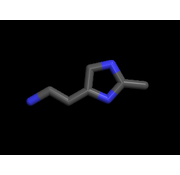Methylhistamine RP from urine
Methylhistamine (Urine HCL) is determined from an acidified urine sample collected during the 2nd morning urine. This test is useful when fecal histamine scores are normal, but there are histamine-like symptoms. This is more of a histamine problem within the body than in the intestines.
Sometimes a diet prior to this test is advised.
It depends on the purpose of the diagnosis whether you want to avoid histamine releasers prior to the test or not.
In normal situations following a diet is not a good idea, because you won't have a representative situation. It is advisable to stop taking histamine inhibitors prior to the test if possible (for instance by not taking any for 2 days prior to the test).
Besides the histamine-rich foods you also have foods that can indirectly trigger a histamine reaction, which we call the histamine releasers. So you won't be affected immediately, it can just take a few days.
- strawberry, pineapple, grapes, kiwi, mango, papaya, figsFood intolerance test
- cocoa and chocolate
- drop
- eggs
- Herbs and spices, ginger, cinnamon, cardamon, curry, coriander, laos,
- paprika, pepper and vanilla
- legumes, nuts, seeds and peanuts
- seafood (shrimps, crabs and mussels)
- pork
As you can see there are quite a few foods to which you can react. But to which foods do you react the most, what bothers your body the most? Foods to which you are sensitive can weaken your immune system. It is therefore important to know what foods you can and cannot eat in order to reduce your symptoms. A food intolerance test provides clarity.
Histamine intolerance causes many different symptoms. Sometimes it is difficult to determine whether the complaint is from a histamine intolerance, an allergic complaint or from an intolerance. This is because the nature of the complaints are close together.
- flushing (feeling of warmth and redness of the skin)
- itching of the nose
- sneeze
- runny nose
- edema
- turmoil
- poor sleep
- migraine
- red itchy swellings on the skin
- palpitations
- diarrhea
- intestinal cramps
- abdominal pain
This is a metabolite (breakdown product) of histamine and is used in screening for mastocytosis, a disorder surrounding systemic mast cell activation such as anaphylaxis and other forms of systemic allergic reactions.
Methylhistamine determination is particularly useful when fecal histamine scores are normal, but histamine-like symptoms are evident. This is then more of a histamine problem within the body than in the intestines.
Reference value should be between 70 and 250 μg/g Kreatinine
The optimal value is between 77 and 225 μg/g Kreatinine.
Increased value
If the value of histamine in the urine is also increased, this is an indication of a high histamine load. The degrading capacity is insufficient. A diet low in histamine and histamine inhibiting medication can be advanced.
When methylhistamine has been shown to be elevated, but the value of histamine in the urine is normal or low, then the degrading capacity is adequate.
Low value
A normal or low histamine value in the urine is an indication of a low histamine load. So any complaints are not caused by a histamine load.
A high level of histamine with a low level of methylhistamine may indicate that histamine is not being converted sufficiently to methylhistamine. The conversion of histamine to methylhistamine takes place via the enzyme methyltransferrase in the liver. A low histamine diet and a liver supporting and histamine inhibiting intervention will have to be started in consultation with your therapist.




